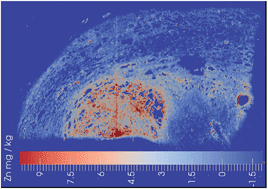Elemental bio-imaging using laser ablation-triple quadrupole-ICP-MS
Abstract
Elemental bio-imaging (EBI) of trace metal distributions in tissue sections is typically performed by laser ablation-single quadrupole-inductively coupled plasma-mass spectrometry (LA-ICP-SQ-MS) in which the sensitivity of biologically relevant elements such as Fe may be inhibited by polyatomic interferences. The triple quadrupole ICP-MS (ICP-QQQ-MS) is designed to reduce interferences and was examined for its potential application to EBI. Three tune modes; a no-gas, an H2, and an O2/H2 tune were developed and investigated for their suitability. All three performed well with high signal to noise ratios and low limits of detection. The O2/H2 tune was applied to a prostate cancer biopsy sample, with high levels of Zn found in the area correlating with the cancer. The oxygen mass shift was applied to image P and Se in a mouse brain. The unique focussing properties of the ICP-QQQ-MS and the ability to use mixed cell gases provided sensitive analyses of all measured isotopes with the O2/H2 tune, including those unaffected by mass shift reactions.

- This article is part of the themed collection: JAAS 30th anniversary


 Please wait while we load your content...
Please wait while we load your content...